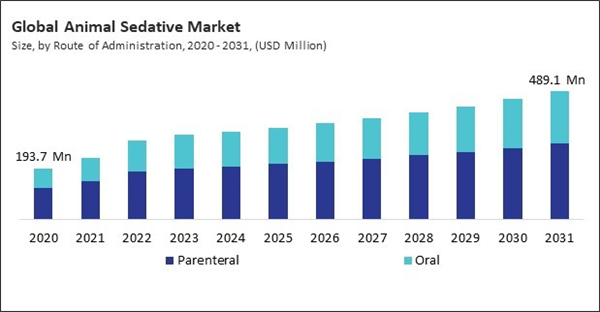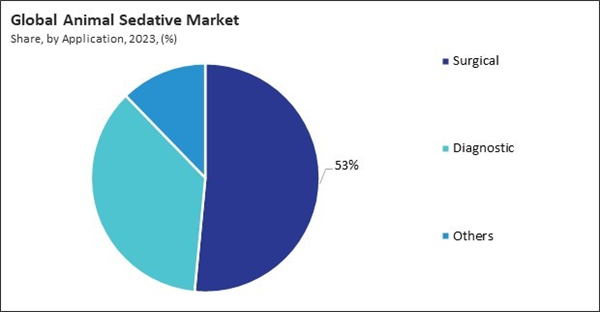The Global Animal Sedative Market size is expected to reach $489.1 million by 2031, rising at a market growth of 5.5% CAGR during the forecast period.
The Asia Pacific region is seeing an expansion of veterinary clinics, hospitals, and specialty centers offering comprehensive healthcare services for animals. This expansion includes advanced diagnostic capabilities and surgical interventions, where sedatives are essential for safe and effective treatment. Consequently, the Asia Pacific region would acquire nearly 27% of the total market share by 2031.
There is a growing recognition of animals as sentient beings deserving of humane treatment. This perspective is driving demand for sedatives that minimize stress, anxiety, and pain during veterinary procedures, ensuring animals are treated with compassion and care. Similarly, pet owners and the general public are increasingly educated about animal welfare issues and expect high standards of care for their pets. Hence, a rising focus on animal welfare propels the market's growth.
Additionally, the growing specialization within veterinary medicine, such as dermatology, dentistry, oncology, and orthopedics, has led to a higher demand for sedatives tailored to specific medical procedures. In addition, the establishment of specialty veterinary centers focused on specific areas of expertise, such as emergency care, critical care, and rehabilitation, drives the need for advanced sedation techniques. Thus, the expansion of veterinary services is driving the market's growth.
However, Sedative products often involve high procurement costs for veterinary practices. This includes the initial purchase of sedative formulations and ongoing expenses related to anesthesia equipment, monitoring devices, and disposables. In addition, veterinarians must weigh the cost-effectiveness of using sedatives against alternative methods of restraint or anesthesia. Thus, the high cost of sedative products is hindering market growth.
Moreover, restrictions on transportation and logistics disrupted the supply chain for pharmaceutical products, including these sedatives. In addition, veterinary clinics and hospitals shifted their focus to emergency and essential care services during the pandemic, prioritizing treatments that did not require sedation unless necessary. Thus, the COVID-19 pandemic had a negative impact on the market.
The Asia Pacific region is seeing an expansion of veterinary clinics, hospitals, and specialty centers offering comprehensive healthcare services for animals. This expansion includes advanced diagnostic capabilities and surgical interventions, where sedatives are essential for safe and effective treatment. Consequently, the Asia Pacific region would acquire nearly 27% of the total market share by 2031.
There is a growing recognition of animals as sentient beings deserving of humane treatment. This perspective is driving demand for sedatives that minimize stress, anxiety, and pain during veterinary procedures, ensuring animals are treated with compassion and care. Similarly, pet owners and the general public are increasingly educated about animal welfare issues and expect high standards of care for their pets. Hence, a rising focus on animal welfare propels the market's growth.
Additionally, the growing specialization within veterinary medicine, such as dermatology, dentistry, oncology, and orthopedics, has led to a higher demand for sedatives tailored to specific medical procedures. In addition, the establishment of specialty veterinary centers focused on specific areas of expertise, such as emergency care, critical care, and rehabilitation, drives the need for advanced sedation techniques. Thus, the expansion of veterinary services is driving the market's growth.
However, Sedative products often involve high procurement costs for veterinary practices. This includes the initial purchase of sedative formulations and ongoing expenses related to anesthesia equipment, monitoring devices, and disposables. In addition, veterinarians must weigh the cost-effectiveness of using sedatives against alternative methods of restraint or anesthesia. Thus, the high cost of sedative products is hindering market growth.
Moreover, restrictions on transportation and logistics disrupted the supply chain for pharmaceutical products, including these sedatives. In addition, veterinary clinics and hospitals shifted their focus to emergency and essential care services during the pandemic, prioritizing treatments that did not require sedation unless necessary. Thus, the COVID-19 pandemic had a negative impact on the market.
Driving and Restraining Factors
Drivers- Rising focus on animal welfare
- Expansion of veterinary services
- Increasing pet ownership globally
- High cost of sedative products
- Limited availability of specialized equipment
- Supportive care in chronic conditions
- Increasing veterinary telemedicine and home care
- Adverse effects and safety concerns
- Limited pharmacological options
Route of Administration Outlook
By route of administration, the market is divided into parenteral and oral. The oral segment procured 40% revenue share in the market in 2023. Oral administration does not require needles or syringes. This can be less stressful for animals and more convenient for owners and veterinary staff.Application Outlook
Based on application, the market is divided into surgical, diagnostic, and others. In 2023, the diagnostic segment procured 36% revenue share in the market. Sedatives often calm animals and reduce movement during diagnostic imaging procedures such as X-rays, ultrasounds, CT scans, and MRIs.Animal Type Outlook
Based on animal type, the market is divided into dogs, cats, horses, and others. The cats segment attained 25% revenue share in the market in 2023. Regular veterinary visits, including vaccinations, check-ups, and minor procedures, often necessitate using sedatives for cats.Drug Class Outlook
On the basis of drug class, the market is segmented into phenothiazines, benzodiazepines, alpha-2 adrenergic receptor agonists, butyrophenones, and others. In 2023, the benzodiazepines segment attained 24% revenue share in the market. Benzodiazepines, such as diazepam and midazolam, are highly effective in reducing stress and anxiety in animals. This makes them invaluable for calming animals during veterinary visits, grooming, transportation, and other potentially stressful situations.End Use Outlook
Based on end use, the market is categorized into hospitals and specialty centers. The specialty centers segment witnessed 48% growth rate in the market in 2023. Specialty centers provide specialized veterinary care in specific areas such as oncology, neurology, cardiology, dermatology, and emergency critical care.Regional Outlook
Region-wise, the market is analyzed across North America, Europe, Asia Pacific, and LAMEA. The North America region witnessed 38% revenue share in the market in 2023. North America has one of the highest rates of pet ownership globally, with a large population of dogs, cats, and other companion animals.List of Key Companies Profiled
- Koninklijke Philips N.V.
- Hoffmann-La Roche Ltd.
- Hologic, Inc.
- Visiopharm A/S
- Paige AI, Inc.
- PathAI, Inc.
- Aiforia Technologies Plc
- Indica Labs, Inc.
- Optrascan, Inc. (Optra Ventures, LLC)
- MindPeak GmbH
Market Report Segmentation
By Route of Administration- Parenteral
- Oral
- Dogs
- Cats
- Horses
- Others
- Alpha-2 Adrenergic Receptor Agonists
- Phenothiazines
- Benzodiazepines
- Butyrophenones
- Others
- Hospitals
- Specialty Centers
- Surgical
- Diagnostic
- Others
- North America
- US
- Canada
- Mexico
- Rest of North America
- Europe
- Germany
- UK
- France
- Russia
- Spain
- Italy
- Rest of Europe
- Asia Pacific
- China
- Japan
- India
- South Korea
- Singapore
- Malaysia
- Rest of Asia Pacific
- LAMEA
- Brazil
- Argentina
- UAE
- Saudi Arabia
- South Africa
- Nigeria
- Rest of LAMEA
Table of Contents
Chapter 1. Market Scope & Methodology
Chapter 2. Market at a Glance
Chapter 3. Market Overview
Chapter 4. Global Animal Sedative Market by Route of Administration
Chapter 5. Global Animal Sedative Market by Animal Type
Chapter 6. Global Animal Sedative Market by Drug Class
Chapter 7. Global Animal Sedative Market by End Use
Chapter 8. Global Animal Sedative Market by Application
Chapter 9. Global Animal Sedative Market by Region
Chapter 10. Company Profiles
Companies Mentioned
- Zoetis, Inc.
- Virbac
- Dechra Pharmaceuticals PLC
- Merck & Co., Inc.
- Bimeda, Inc.
- Ouro Fino Saude Animal Participacoes S.A.
- vetcare. fi.
- Chanelle Pharma (Exponent)
- Randlab Australia Pty Ltd.
- Troy Laboratories Pty Ltd.
Methodology

LOADING...










